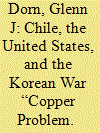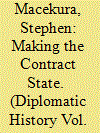|
|
|
Sort Order |
|
|
|
Items / Page
|
|
|
|
|
|
|
| Srl | Item |
| 1 |
ID:
193502


|
|
|
|
|
| Summary/Abstract |
On May 2, 1952, Chilean President Gabriel González Videla, a staunch U.S. ally, suddenly terminated the Washington Agreement governing the sale of copper to the United States, in effect, imposing an embargo and nationalizing the export of copper in the midst of the Korean War. For U.S defense planners, who had based their mobilization and rearmament program upon the strict control of copper, steel, and aluminum, the metals that enabled them to “control practically all production” in the nation, this was an unexpected and dangerous blow. “The loss that we would sustain by not having access to Chilean copper would be irreparable,” the head of the National Production Administration (NPA) Copper Division warned, “as there is no conceivable way whereby we could meet current programs.”1 Although it was always clear that the embargo was a negotiating tool rather than a belligerent act, subsequent threats to sell copper across the Iron Curtain and nationalize the mines lent the move additional gravity. This “copper problem” only ended when González Videla’s successor, Carlos Ibañez del Campo, under U.S. pressure, enacted a new copper law, the Nuevo Trato (“New Deal”), in 1955. The Nuevo Trato represented a triumph for rightists in Chilean politics, the failure of Chilean efforts to challenge the U.S. government and copper companies, and a temporary lull in efforts to exert control over Chile’s most critical industry.
|
|
|
|
|
|
|
|
|
|
|
|
|
|
|
|
| 2 |
ID:
193503


|
|
|
|
|
| Summary/Abstract |
“Probably this treaty stands alone in the history of diplomacy, as an important treaty conceived, initiated, prosecuted and completed, without being preceded or attended by protocols or despatches,” declared U.S. Secretary of State William Henry Seward after he arranged the purchase of Russian America (Alaska).1 The treaty had indeed been negotiated in a highly unconventional manner. Seward and the Russian minister in Washington, Eduard Stoeckl, worked out the terms swiftly and almost alone.2 Stoeckl’s written instructions from his government were only a few pages long. Seward, who received no formal directive at all, merely consulted briefly with U.S. President Andrew Johnson before going ahead.3 No detailed records were kept by either side.
|
|
|
|
|
|
|
|
|
|
|
|
|
|
|
|
| 3 |
ID:
193499


|
|
|
|
|
| Summary/Abstract |
Robert Nathan was not the most prominent figure in U.S. President Franklin Roosevelt’s wartime cabinet, but he got a taste of the public spotlight in April 1942 when Life magazine ran a profile of him. The journalist Joseph Thorndike, Jr. followed Nathan through a typical week in Washington, D.C. Thorndike lauded Nathan’s jocular personality and modest lifestyle. Photographs accompanying the article showed Nathan exercising in a boxing ring and preparing a pancake breakfast at home. What most impressed Thorndike, though, was the thirty-five-year-old economist’s statistical analysis and planning work for the U.S. government. Nathan, an ardent New Dealer, provided crucial research in the administration’s pioneering efforts to craft national income estimates during the 1930s. In January 1942, he joined the War Production Board. Wielding charts and graphs as weapons in fierce debates over how best to mobilize for the war, he made calculated projections of how to boost defense production while preventing another domestic depression. In Thorndike’s telling, Nathan was a patriotic public servant who used his statistical acumen to help fight the Great Depression and World War II.
|
|
|
|
|
|
|
|
|
|
|
|
|
|
|
|
| 4 |
ID:
193500


|
|
|
|
|
| Summary/Abstract |
On the evening of April 12, 1962, U.S. President John F. Kennedy and First Lady Jacqueline Kennedy hosted Mohammad Reza Shah and Empress Farah Pahlavi of Iran at the White House for a glamorous dinner and reception. The visit constituted the first meeting between the President and the Shah, who had single-handedly held the reins of Iran since the U.S.-sponsored coup of 1953. Much was at stake. Although Iran was a staunch U.S. ally, the Democratic President and the Shah disagreed sharply on the road the country should take. Kennedy had come to power through idealistic rhetoric that considered human rights and democratization a significant part of modernization and a practical way of averting radical left-wing revolutions.1 The Shah, the autocratic leader of an increasingly oil-rich nation, believed socioeconomic development in Iran had to precede democratization to prevent destabilization. He had set out on the visit to convince the president and the U.S. public that Iran’s progress meant royal leadership—not U.S.-style democracy.
|
|
|
|
|
|
|
|
|
|
|
|
|
|
|
|
| 5 |
ID:
193501


|
|
|
|
|
| Summary/Abstract |
Start with manganese (Mn). With an atomic number of twenty-five, Mn sits next to chromium and iron in the middle of an industrially indispensable row of what are called “transition metals” on the periodic table. The element is named for the Greek region of Magnesia—confusingly also the origin of the chemically very different magnesium, itself not to be confused with the magnetic lodestone also associated with the region—and in its most common form as manganese oxide it has been used for pigmentation and in glassmaking since antiquity. It is also essential to good steelmaking. At high temperatures, manganese forms a high-melting sulfide, preventing the formation of liquid iron sulfide and making high temperature steel more workable. Steel alloys of between eight percent and twelve percent manganese achieve significantly higher tensile strength, and as a deoxidizer manganese helps prevent corrosion and wear, especially in low-cost stainless steel. Aluminum, vanadium, and a number of other transition metals have similar properties to manganese, but as the authors of a 1952 report to U.S. President Harry Truman’s administration on the United States’ long-term material supply needs noted, in the early 1950s—as today—there was really no practical way to produce steel at an industrial scale without manganese. And in the 1950s, with steel a vital commodity at the heart of the U.S. civilian and military economies, the United States did not produce very much manganese.
|
|
|
|
|
|
|
|
|
|
|
|
|
|
|
|
|
|
|
|
|